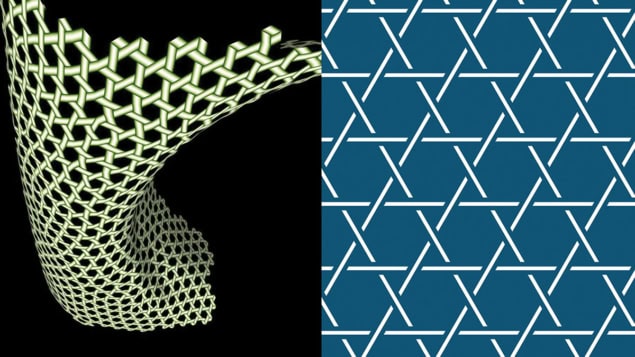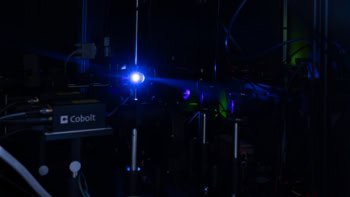Stephen Ornes explores the strange properties of lattices that are bendy at the edges but not in the bulk – and how they could inspire novel metamaterials that can store data or lead to building materials that only fail in predictable ways

Progress in physics often depends on persistence.
Take Tom Lubensky, a condensed-matter physicist at the University of Pennsylvania in the US. He had been trying to get his colleague Charles Kane to listen to him, but Kane wasn’t having any of it. They inhabit offices on the same corridor of the Department of Physics and Astronomy at Pennsylvania and have collaborated on arcane problems in the past, but their work typically keeps them separated by many orders of magnitude. Lubensky focuses on “soft” materials, such as complex fluids and liquid crystals, which keep him in a mechanical, Newtonian world. Kane toils in a much smaller domain. He studies the electronic properties of solids and is more likely to interact with materials with exotic quantum behaviour.
This time round, Lubensky had been investigating a certain class of lattice that can have movement at the edges – but not in the bulk of the material. The idea that the edge of a material would behave differently from its interior reminded Lubensky of “topological insulators” – materials first discovered about 10 years ago in which electrons can flow easily along the surface but are stopped dead in their tracks in their bulk. But in the autumn of 2012 when Lubensky wandered down the corridor to tell Kane he had seen a connection between the mechanical vibrations of lattices and the quantum behaviour of exotic electronic systems, his colleague remained sceptical.
Lubensky told Kane he suspected that the dynamical matrix – which provides a mathematical description of all the possible motions of a lattice – looked similar to a description of how charge flows on a topological insulator. However, Lubensky couldn’t see the path from one concept to the other. “I went into that discussion with the bias that what Tom was doing had nothing to do with what I was doing,” recalls Kane. “We work in very different fields.” Kane simply couldn’t see a connection – at least not at first. He spent his time solving the Schrödinger equation, which has a single time derivative. Lubensky worked with Newton’s equations, which are second-order in time.
The two physicists could not have been farther apart, at least in terms of condensed matter, and Kane doubted they would find any link between the particular lattices he was studying and quantum electronics. Still, Lubensky persisted and Kane finally agreed to hear him out. “When we sat down and started talking together,” says Kane, “I began to appreciate how similar the two were. Tom already understood that in the back of his mind.” And so a collaboration emerged, in which the two physicists not only developed connections between the mechanical behaviour of this class of lattice and topological insulators, but also with other exotic electronic systems, such as “quantum Hall fluids” – 2D systems in which the electrical conductance is quantized.
Lattice work
A lattice is a tried-and-tested workhorse in any condensed-matter physicist’s toolbox. It’s usually represented as a 2D grid or 3D array, in which balls are linked by springs in periodic, repeating patterns. Its power lies in its simplicity: a lattice can be used to model everything from atoms arranged in crystals to the bonds that hold long-chain polymers together. Lattices have been used to explore how structures behave after being compressed, pushed, pulled, twisted or otherwise tortured. They’re useful at every order of magnitude, both to study how a material withstands forces and under what conditions it fails.
1 Floppy or not
 (a) A 2D lattice made from sets of four points connected by springs will change its geometry when perturbed. (b) But adding springs along the diagonals will lead to the lattice regaining its shape when the perturbing force is removed.
(a) A 2D lattice made from sets of four points connected by springs will change its geometry when perturbed. (b) But adding springs along the diagonals will lead to the lattice regaining its shape when the perturbing force is removed.
Lattices can be rigid, which means the points can be wiggled but the structure won’t change. They can, however, also have “floppy” modes, which means that slight perturbations can cause a mode to “flop” with minimal energy – leading to big changes in the structure. Imagine, for example, a square 2D lattice with every set of four points connected by four springs (figure 1). Push gently on one point and you can change the geometry of the lattice, turning it into a parallelogram or even, with further pushing, collapsing it down to a straight line. But now imagine adding springs to the square lattice along the diagonals. After a small push on one of the corners, the lattice will return to its original shape. By adding the two springs, the lattice is no longer floppy but is now stable and rigid. Whether a lattice has floppy modes or not depends on the balance between degrees of freedom – how its points can move – and the number of bonds, which restrict that motion.
Lubensky had been particularly interested in lattices that are on the verge of mechanical collapse. He refers to these as “Maxwell lattices”, in honour of the Scottish physicist James Clerk Maxwell, who in 1865 laid out the conditions under which a network would be rigid. According to Maxwell, a lattice cannot be rigid unless the number of constraints equals or exceeds the degrees of freedom. In particular, the average number of point-to-point connections in a rigid lattice must be at least twice the number of dimensions. So in a 2D lattice, the average number of connections must be at least four. A Maxwell lattice is rigid, but just barely: Its average number of connections is exactly twice the number of dimensions.
2 Kagome baskets
 (a) Kagome or basket-weave lattice with four connections per site; (b) the twisted kagome lattice, also with four connections per site obtained from the kagome lattice by counter-rotating triangles about shared sites.
(a) Kagome or basket-weave lattice with four connections per site; (b) the twisted kagome lattice, also with four connections per site obtained from the kagome lattice by counter-rotating triangles about shared sites.
Examples of Maxwell lattices in 2D (see figure 2 and 3) include the kagome lattice, named after a pattern found in a type of Japanese basket. There is also a “twisted” kagome lattice, obtained by counter-rotating corner-sharing triangles of the kagome lattice.
Researchers use such lattices to analyse mechanical instability – where the lattices fail – for a wide range of systems, from architecture to biological networks. They’ve also been used to predict the point at which spheres are packed so closely together that they become rigid. This “jamming threshold” can be observed in sand: if you run your fingers through lightly packed sand, the grains flow easily, but if you try to move your fingers through hard-packed sand, it remains locked in place and resists invasion. Geometry in such systems trumps composition: the material itself matters less than how the nodes and bonds that make it up are arranged.
3 Model approach
 Vincenzo Vitelli and colleagues at the University of Leiden created physical models of floppy lattices. This model is a mechanical analogue of what happens to the nodes (white dots) at the border of a lattice with floppy modes. At one end, the node can be wiggled back and forth, at the other end it’s stuck.
Vincenzo Vitelli and colleagues at the University of Leiden created physical models of floppy lattices. This model is a mechanical analogue of what happens to the nodes (white dots) at the border of a lattice with floppy modes. At one end, the node can be wiggled back and forth, at the other end it’s stuck.
Floppy at the fringes
Lubensky was interested in lattices that are stable – but only just. But then he and his colleagues made a surprising observation. They found that the simple twist that produces a twisted kagome isn’t just a curious change of geometry. It resulted in a drastic change. A conventional kagome lattice may have floppy modes in its bulk, but the twisted lattice becomes “gapped” – which means those floppy modes are prohibited in the bulk.
This transformation of surface modes reminded Lubensky of the appearance of surface electronic states that appear when the bulk electronic modes of a topological insulator develop a “gap” – that is, states of energy that are prohibited in the material. In the lattice, that gap relates to floppy modes; in topological insulators, it relates to the movement of electrons. That’s why Lubensky went to see Kane – he was searching for a connection between the two problems. After they’d talked, Kane mulled over the dynamical matrix and saw what Lubensky was talking about. Something did seem familiar to him: the dynamical matrix almost looked like an operator. In fact, it looked a lot like the Hamiltonian of the surface states of a topological insulator, except that it lacked the “valence band” characteristic of an insulator.
Undoubtedly like many moments in history that have pushed a field forward, Kane found a solution just before he drifted off to sleep one night in December 2012. “I was lying in bed at home, trying to think about this, and realized after some effort that I knew how to do it,” Kane recalls. “I wrote to Tom the next day and said I could turn it into a problem I knew how to solve.” In hindsight, Kane says, the approach seems almost obvious. In fact, it was buried in a previous paper by Lubensky and other collaborators (2010 Phys. Rev. Lett. 104 085504). “If you go back and look at that paper, it really does smell like the same kind of topological boundary modes that occur in electronics systems.”
Kane thought that he could break down the matrix by effectively taking the square root of it, an approach once used by Paul Dirac to unify quantum theory with special relativity. Kane and Lubensky ultimately produced a result that, when regarded as a Hamiltonian, also described a topological insulator. The pair reported the connection between the two fields in the January 2014 issue of Nature Physics (10 39) – a paper that attracted the attention of Vincenzo Vitelli, a soft-matter theorist at the University of Leiden in the Netherlands.
LEGO heads
“One thing that’s fascinating about Charlie and Tom is the combination of research areas,” says Vitelli. “Charlie is a leading expert on electronic materials, and Tom has worked on many things, including soft-matter materials. Their Nature Physics paper was a bridge between those areas.” But when he first read the article, Vitelli’s immediate thought was that he wanted to see the phenomenon for himself. “In line with the spirit of the soft-matter community, the first question that came to our minds was: ‘Can you literally bring this difficult concept to your fingertips? Can we build this bridge to understanding?’ ”
Despite having been trained as a theorist, Vitelli believes in the power of playing with and learning from real, physical objects, such as LEGO bricks – a stack of which he keeps in his office. He and his team used various building blocks, which he describes as “LEGO on steroids”, to build a physical representation of the lattice with the same properties as those described by Lubensky and Kane. To the outsider, their contraption looks like a complicated series of transparent “flippers” of the kind found in pinball machines, connected by springs and rods to each other – and to a bar that holds it all together.
The resulting chain, based on Kane and Lubensky’s description, might look curious but it behaves like their lattice and aptly demonstrates the predicted floppy modes at the border (figure 3). Vitelli’s models are, in other words, a mechanical analogue for what happens to electrons in a topological insulator; to watch videos of the models in action is to witness a quantum effect on the macro scale. “They’re really quite remarkable because they have the property we discussed,” says Lubensky. “At one end, you can wiggle the bond the back and forth, and at the other end it’s stuck.”
Vitelli kept going and found that with some minor adjustments – and by tilting the chain up on its end – a similar device could actually conduct the mechanical motion along its length, propelled by gravity. In a video of the device (see below), one can see the “kink” at the edge travel, flipper by flipper, through the chain. Vitelli called this phenomenon a “flipper soliton” – a wave-like phenomenon that transports energy along the length. So whereas Lubensky and Kane had predicted the floppy mode would remain localized on the border and act as an insulator, Vitelli’s mechanical lattice – this chain of flippers – showed that the mode can travel through the bulk, which therefore acts as a conductor, too.
Theoretically, the chain behaved as though the edge mode moved the entire structure, which is a key difference between the quantum and classical states. When you push on an electron, in contrast, it doesn’t disturb the whole structure underneath. Vitelli and his co-authors therefore went searching for the origins of the phenomenon, which centred on the fact that Lubensky and Kane had limited their work to using linear elasticity. Once you treat the lattice as a nonlinear system, however, the soliton appears. The behaviour of the soliton, in other words, is built into the topology of the lattice itself.
Making metamaterials
The observation that floppy modes can in fact reach the interior of a lattice suggests yet another direction for research. “It tells you that you can use defects in a positive way,” says Vitelli. In a paper published earlier this year (Nature Phys. 10.1038/nphys3185), Vitelli and his team showed that it is possible in practice to actually build such modes – as defects – into the fabric of structures like the Kagome lattice studied by Lubensky and Kane.
Once again, the Dutch physicists turned to LEGO-like building blocks to demonstrate the phenomenon on a macroscopic scale. Using physical models in 2D, they showed that these defects, just as with the floppy edge modes, could be constructed to remain localized or to propagate as vibrations through the lattice. And like the floppy edge modes, these defects behaved like mechanical analogues of topological insulators. But what is interesting is that a material constructed to include these sorts of topologically protected defects can be classified as a “metamaterial”.
Metamaterials are artificially engineered substances – typically built from collections of rods or rings – with properties that arise from how the component parts are put together, not the composition of those parts themselves. It’s a case of geometry, not chemistry, ruling the roost. Metamaterials are most familiar in the pursuit of cloaking devices that can hide an object from, say, incoming light or sound, but they are essentially just a network of nodes connected by links – a lattice in other words. In a recent paper published with Jayson Palouse and Anne Meeussen (arXiv:1502.03396), Vitelli has described a metamaterial in which buckling regions are sculpted into its topology. “We can control the states of self stress, depending on where we put the defects,” he says.
Metamaterials such as those described by Vitelli and his team might be used to store data, provided they can be made very small. At larger scales, such substances might even lead to new building materials that can only fail in predictable ways. But perhaps the most promising use for such a material is in robotics or “smart” metamaterials, where the floppy modes could be activated by tiny built-in motors. (Right now, the solitons only arise when someone pushes on an edge of the lattice.)
Vitelli points out that no-one knows where the research is heading. “Nobody has the crystal ball,” he quips. The groundwork for mechanical-quantum analogues, in the form of floppy modes, has been laid, and now researchers face the challenge of showing that it might be useful. “We need one very cool application,” says Vitelli. “The material has been shown to exist, he says, “but now we need to go beyond that. We have to show that this material does something better than something else.”
Those dreams are a long way from the original work of Lubensky. In fact, Lubensky thinks that he and Kane might have found their connection even sooner if condensed-matter physicists didn’t divide themselves so strongly along quantum and classical lines. “In the end, we were talking about the same underlying mathematics,” he says. Of course, physicists have been studying for decades how lattices hold and fail, but Kane and Lubensky do appear to have established the foundation for a new avenue of investigation. All of which proves the power of persistence.



